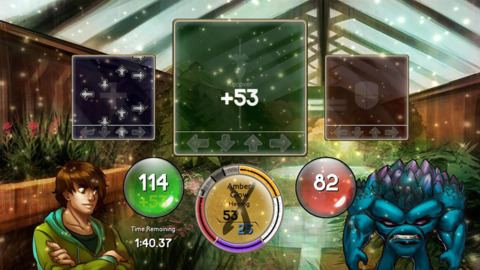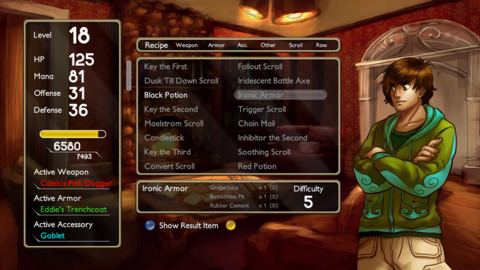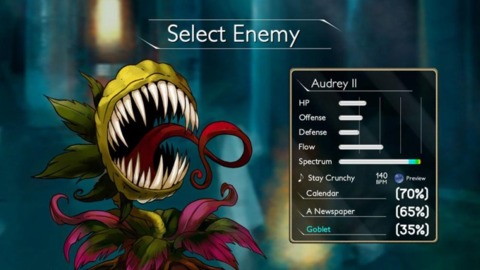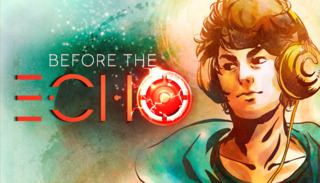Refreshingly Unique, Good Value, A Little Too Repetitive
Last October, Steam saw the release of Iridium Studios’ former Xbox Live Indie Game Sequence. This debut title can only be described as a “rhythm RPG,” combining gameplay elements from Bemani-style rhythm games and standard RPG trappings such as experience and crafting. You play as Ky, a male college student who suddenly wakes up to find himself trapped in a tower filled with monsters and must fight his way up to survive. Guiding him is his assigned “shepherd,” Naia, who gives her advice and direction to you via intercom. As you progress up the tower, more is revealed about the nature of your situation and the role Naia plays in all of this.

The majority of the game is spent fighting the monsters in the tower. While fighting you are presented with three separate “fields” of familiar-looking arrows: a defense field to stop incoming attacks, a spell field to cast offensive, support, and healing spells, and a mana field to regenerate mana. Also displayed are two orbs showing health for you and the enemy as well as a spell wheel that shows your current mana and lets you select spells to cast. The basic goal is to drain all of the enemy’s health before they do the same to you or the music track ends. Throughout the battle, isolated groups of arrows descend through the defense field, and you must rhythmically press the correct arrow as it reaches the bottom to guard against the enemy’s attack. Each arrow that makes it through knocks off a bit of your health, and colored arrows multiply the amount of damage done to you. When you cast a spell, arrows in the spell field descend in a predefined pattern unique to each spell. You must successfully hit all arrows in the pattern in order to cast the spell. Meanwhile a constant stream of arrows are falling in the mana field. Every arrow you hit there restores one mana point, and there is no penalty for letting them pass by. Only one of the three fields can be active at a time, so you are constantly switching between them, trying to balance doing enough damage to the enemy to kill it before time expires (usually about two or three minutes per battle) with spending enough time defending so you don’t get killed yourself. The fast-paced chaos takes some getting used to, but this unique take on such a worn out genre is the game’s greatest strength.
The controls are pretty well designed for a 360 controller given how many things are going on at once. Using both the D-pad and face buttons to pound out the note sequences with your thumbs feels natural, and switching fields with the left and right triggers and selecting spells with the analog stick then casting them with the bumpers all feels pretty intuitive. The keyboard controls work just as well with WASD and the arrow keys for notes, Q and E to switch fields, and the number keys bound to your different spell slots.

The rest of the game consists of the RPG wrapper that the battle gameplay is contextualized in. You gain experience by fighting monsters (Even if you lose the battle, you still gain some experience relative to how low the enemy’s health was.) and level up, boosting stats like health, mana, offense, and defense. Equipping gear that enemies drop also boosts your stats or provides unique effects like lowing mana cost of spells or increasing critical hit chance. After defeating an enemy, you have a chance to get one to three items that play into the game’s crafting system. At the start of each floor of the tower, you are given several recipes to craft. These could be equipment, new spells, or (more importantly) the key to unlock the next floor of the tower. The ingredients for each recipe are all random non sequiturs, such as a brick, a bottomless pit, and a calendar to craft one of the keys. When you acquire the necessary items you select the recipe and are taken to a screen where decide how much experience to spend in order to boost the chance of success (on a scale from 0.1% - 95%). The cost of boosting the success rate increases exponentially as you approach the top, and spending enough experience can take you back down a level. Fortunately if the recipe fails you don’t lose the ingredients, but you do lose the experience you spent.

Thus the pattern becomes reach a new floor, get your recipes, chose battles based on what items each enemy drops, and grind against them until you have what you need to craft the key for that floor. Once you have the key, you are faced with the guardian of that floor. Each guardian has a unique special ability that randomly gets cast (at most once per battle) while you are fighting the floor’s normal monsters. These guardian effects include things like locking which field is active for a few seconds, increasing the speed of the arrows, or completely draining your mana. When you fight the guardians themselves however, these abilities can be cast more often, making the fights tougher. After defeating a guardian you ascend the stairs and the pattern repeats on each of the tower’s seven floors. While the unique fighting mechanics are the game’s strength, the repetitive nature of the underlying structure is its weakness. Too often you find yourself fighting the same enemy over and over to get some grape juice with a 64% drop rate. The fact that the music track for the battle is the same each time you fight that enemy doesn’t help things either. It’s definitely not a game to play in large chunks of time, and I usually needed to take a break after one or two floors. Perhaps the game is simply too long -- the 12+ hour adventure bullet point on the "back of the box" is pretty spot on.
Overall, Sequence is a game based on a cool, unique idea that may have been stretched out longer than it needed to be. However, at only five dollars on Steam it certainly has a lot of value. The gameplay is supported by a fantastic visual style and solid original soundtrack collected from various electronic music artists. If you’re the type of person who enjoys rhythm games and are looking for a new twist on the genre it’s definitely worth checking out. This game is a great start for the first game of the small, two person team at Iridium, and I look forward to whatever project they work on next.
